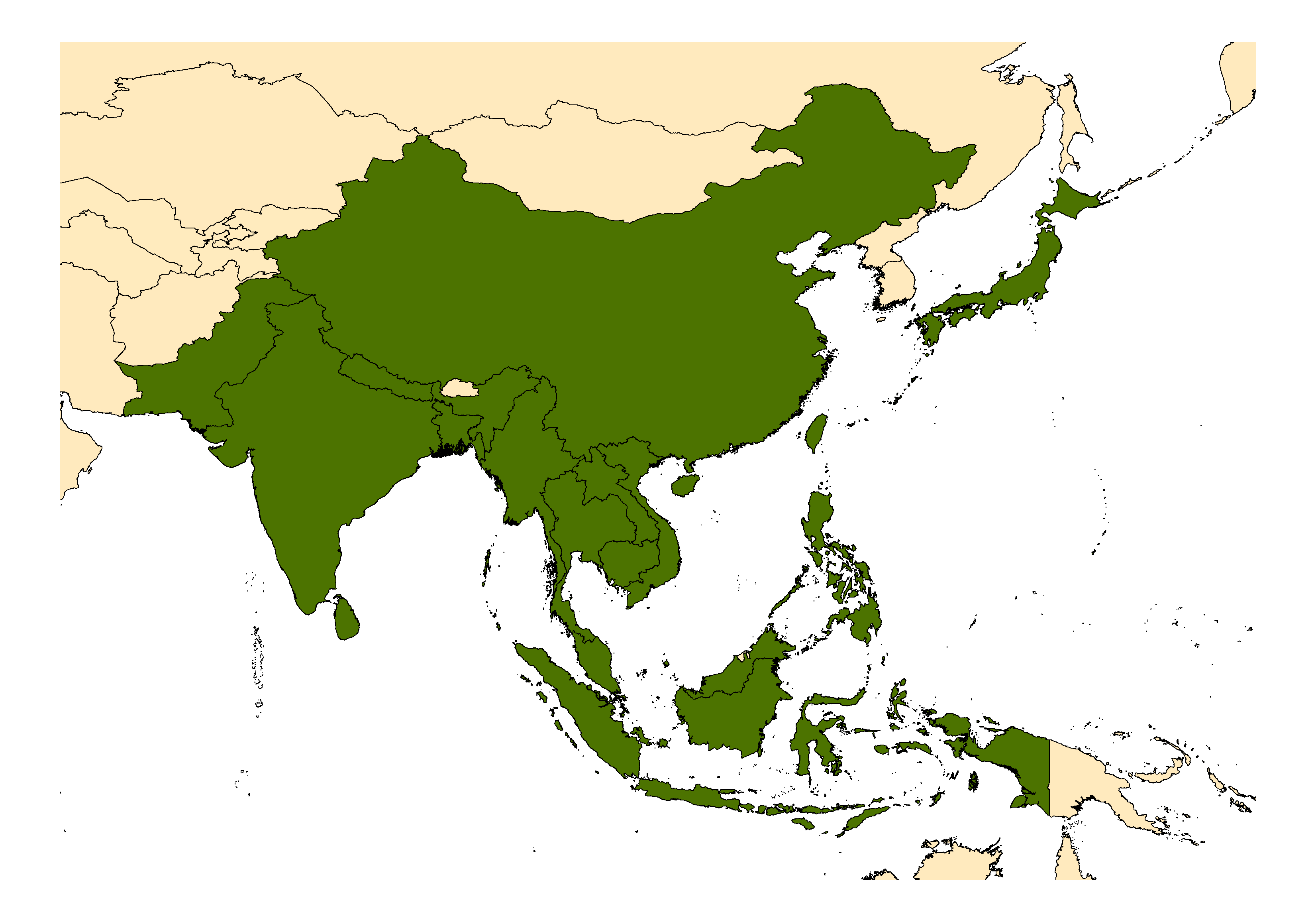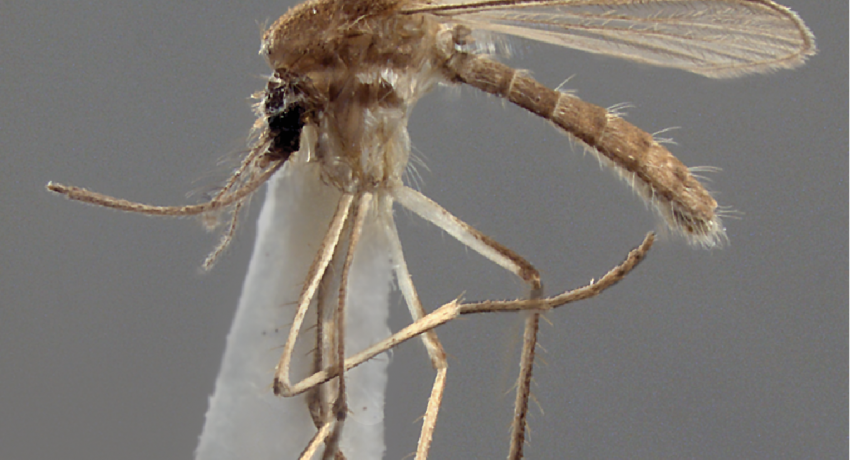INDOMALAY & ORIENTAL REGIONS
[Guam invasive]
Etymology: dark head (Gr); “head deep blackish-brown”
Culex fuscocephala is differentiated from other Culex species by a distinctly dark colored head, and rows of acrostichal setae on the scutum. Culex fuscocephala belongs to the medically important Univittatus Subgroup, which also includes Cx. neavei Theobald, Cx. perexiguus Theobald and Cx. univittatus Theobald.
Type locality: Peradeniya, [Central], Ceylon [Sri Lanka]
Type depository: Natural History Museum, London, England, United Kingdom (NHMUK)
DIAGNOSTIC CHARACTERS (Click photos to view; mouse over and click large photo to zoom in.)
ADULT (illustrated): Head: Proboscis entirely dark-scaled. Thorax: Distinct double row of acrostichal setae present; mesepimeron with one or two setae; pleuron with broad dark integumental stripes and distinct scale patches. Abdomen: Terga all dark scaled. Legs: Ta-I–III all dark.
LARVA (not illustrated): Head: Dorsal apotome distinctly separated from median labral plate (MLP); seta 1-C slender; setae 5,6-C double. Terminal segments: Siphon tapers gradually.
TAXONOMIC KEYS
Lee et al. 1989a
Darsie & Pradhan 1990
Tanaka 2004a
Rattanarithikul et al. 2005a
![]()
WRBU – Culex (Culex) - Indomalayan Region – Larva
![]()
WRBU – Culex (Culex) - Oriental Region – Adult
![]()
WRBU – Culex (Culex) - Oriental Region – Larva
![]()
WRBU – Culex (Culex) - Eastern Palearctic Region – Adult
![]()
WRBU – Culex (Culex) - Eastern Palearctic Region – Larva
Exemplar DNA sequences
Cx. fuscocephala COI: AB738104–05, HQ398886–88, HQ398890, JQ728237–39, JQ728354, JQ728383, KF406796–800.
BIONOMICS
Immatures
Typical immature habitats of Cx. fuscocephala include rice fields, ground pools, animal borrow pits and temporary puddles, but they have also been recovered from clay pots and coconut shells.
Adults
Adult Cx. fuscocephala feed outdoors on cattle and other livestock, biting humans only when their preferred hosts are scarce. This multivoltine tropical species is active year-round with population peaks of Cx. fuscocephala tied to the monsoon rains. Japanese encephalitis virus multiplying to high titers within 10 days of ingesting very low titers of infected blood meals in Culex fuscocephala and viremia can persist for over four weeks. Along with the primary regional vector, Cx. tritaeniorhynchus Giles, Cx. fuscocephala is an important vector of JBEV.
DISTRIBUTION NOTES
Bangladesh, Cambodia, Guam, Hong Kong, India, Indonesia, Japan, Laos, Malaysia, Myanmar, Nepal, Pakistan, People’s Republic of China, Philippines, Singapore, Sri Lanka, Taiwan, Thailand, Timor, Vietnam.

WRBU VECTOR HAZARD REPORTS
None; View other WRBU Vector Hazard Reports
Available GIS Models:
IMPORTANT REFERENCES (full citations below)
Barraud 1924m (L*)
Barraud 1934: 424 (M*, F, L*)
Bonne-Wepster & Brug 1937a: 80 (M, F*)
Bonne-Wepster & Brug 1939: 1277 (L*)
Bohart 1945: 78 (M*)
Bram 1967b: 184 (M*, F*, P*, L*; bionomics, distribution, taxonomy)
Aslamkhan 1971b (distribution; Pakistan)
Basio 1971b: 55 (M*; bionomics)
Pinhão 1974 (distribution; Timor)
Baisas 1974: 90 (M, F, P, L; taxonomy, bionomics, distribution; Philippines)
Tanaka et al. 1975c: Tanaka et al. 1975c: 219 (bionomics, distribution)
Sirivanakarn 1976: 51 (M*, F*, P*, L*; distribution)
Tanaka et al. 1979: 135 (M*, F*, L*)
Ahmed 1987 (distribution; Bangladesh)
Lee et al. 1989a: 119 (F key, taxonomy, bionomics, distribution, review)
Lee et al. 1989a: 163 (taxonomy, bionomics, distribution, review; as uniformis)
Darsie & Pradhan 1990 (F, L; taxonomy, keys, bionomics, distribution; Nepal)
Suleman et al. 1993 (distribution; Pakistan)
Tanaka 2004a: 12 (P*; taxonomy, key)
Rattanarithikul et al. 2005a (F*, L*; bionomics, distribution, keys)
CURRENT SYNONYMS
syn. uniformis Leicester
1908: 159 (F). Type locality: Batu Gajah, [Perak], Malaya [Malaysia] (NE).
syn. minimus Leicester
1908: 160 (M, F). Type locality: Kuala Lumpur, [Selangor], Malaya [Malaysia] (NE).
syn. taytayensis Banks
1909: 545 (M, F). Type locality: Taytay, Rizal, [Luzon], Philippines (NE).
syn. luteola Theobald
1910c: 378 (F*). Type locality: Peradeniya, [Central], Ceylon [Sri Lanka] (NHMUK).
syn. inelegans Dyar
1920h: 179 (M). Type locality: Los Banos, [Laguna, Luzon], Philippines (USNM).
syn. fuscitarsis Barraud
1924g: 1272 (M*, F). Type locality: Pachmari, Central Provinces, India (NHMUK).
CITED REFERENCES
Ahmed, T.U. (1987). Checklist of the mosquitoes of Bangladesh. Mosquito Systematics, 19(3), 187–200.
Aslamkhan, M. (1971b). The mosquitoes of Pakistan I. A checklist. Mosquito Systematics, 3(4), 147–159.
Baisas, F. E. (1974). The mosquito fauna of Subic Bay Naval Reservation, Republic of the Philippines. San Francisco: Headquarters, First Medical Service Wing (PACAF), San Francisco.
Banks, C. S. (1909). Four new Culicidae from the Philippines. Philippine Journal of Science, 4(6), 275–285.
Barraud, P. J. (1924g). A revision of the culicine mosquitoes of India. Part XIII. Further descriptions of Indian species of Culex L. including three new species. Indian Journal of Medical Research (Calcutta), 11, 1275–1282.
Barraud, P. J. (1924m). A revision of the culicine mosquitoes of India. Part XVII. Indian Journal of Medical Research (Calcutta), 12, 427–434.
Barraud, P. J. (1934). The fauna of British India, including Ceylon and Burma. Diptera. Vol. 5. Family Culicidae, tribes Megarhinini and Culicini (Vol. 5). London: Taylor and Francis.
Basio, R. G. (1971b). The mosquito fauna of the Philippines (Diptera, Culicidae). Manila: National Museum of the Philippines. 198pp.
Basio, R. G., & Basio, L. S. (1971b). On Philippine mosquitoes. VI. Tripteroides (Tripteroides) reiseni, a new species (Diptera: Culicidae). Philippine Journal of Science, 100(2), 103–105.
Bohart, R.M. (Ed.) (1945). A synopsis of the Philippine mosquitoes (Vol. 580). Washington D.C.: United States NAVMED (Bureau of Medicine and Surgery, Navy Department).
Bonne-Wepster, J., & Brug, S.L. (1937a). Nederlandsch-Indische culicinen. Geneeskundig Tijdschrift voor Nederlandsch-Indie [a reprint of 1937b with separate pagination]. 7, 1–105.
Bonne-Wepster, J., & Brug, S.L. (1939). Larven van Nederlandsch-Indische culicinen. Geneeskundig Tijdschrift voor Nederlandsch-Indie, 79, 1218–1279.
Bram, R.A. (1967b). Contributions to the mosquito fauna of Southeast Asia. II. The genus Culex in Thailand (Diptera: Culicidae). Contributions of the American Entomological Institute, 2(1), 1–296.
Darsie, R.F., Jr., & Pradhan, S.P. (1990). The mosquitoes of Nepal: Their identification, distribution and biology. Mosquito Systematics, 22(2), 69–130.
Dyar, H.G. (1920h). A collection of mosquitoes from the Philippine Islands (Diptera, Culicidae). Insecutor Inscitiae Menstruus, 8, 175–186.
Lee, D.J., Hicks, M.M., Debenham, M.L., Griffiths, M., Marks, E.N., Bryan, J.H., & Russell, R.C. (1989a). The Culicidae of the Australasian region. Volume 7. Commonwealth Department of Health, School of Public Health and Tropical Medicine Monograph Series, 2.
Leicester, G.F. (1908). The Culicidae of Malaya. Studies from the Institute for Medical Research, Federated Malay States, 3(3), 18–261.
Pinhão, Rui da Costa (1974). Sôbre a situação zoogeográfica de Timor. Anais do Instituto de Hygiene e Medicina Tropical, 1(1–4), 467–470.
Rattanarithikul, R., Harbach, R.E., Harrison, B.A., Panthusiri, P., Jones, J.W., & Coleman, R.E. (2005a). Illustrated keys to the mosquitoes of Thailand. II. Genera Culex and Lutzia. Southeast Asian Journal of Tropical Medicine and Public Health, 36 (Supplement 2), 1–97.
Sirivanakarn, S. (1976). Medical entomology studies - III. A revision of the subgenus Culex in the Oriental region (Diptera: Culicidae). Contributions of the American Entomological Institute, 12(2), 1–272.
Suleman, M., Khan, K., & Khan, S. (1993). Ecology of mosquitoes in Peshawar Valley and adjoining areas: Species composition and relative abundance. Pakistan Journal of Zoology, 25(4), 321–328.
Tanaka, K. (2004a). Studies on the pupal mosquitoes of Japan. (10) Culex (Culex) (Diptera, Culicidae). Japanese Journal of Systematic Entomology, 10(1), 9–42.
Tanaka, K., Mizusawa, K., & Saugstad, E.S. (1979). A revision of the adult and larval mosquitoes of Japan (including the Ryukyu Archipelago and Ogasawara Islands) and Korea (Diptera: Culicidae). Contributions of the American Entomological Institute, 16, 1–987.
Tanaka, K., Saugstad, E.S., & Mizusawa, K. (1975c). Mosquitoes of the Ryukyu Archipelago (Diptera: Culicidae). Mosquito Systematics, 7(3), 207–233.
Theobald, F.V. (1910c). A monograph of the Culicidae of the World (Vol. V). London.
CITE THIS PAGE
Walter Reed Biosystematics Unit (Year). Culex fuscephala species page. Walter Reed Biosystematics Unit Website, http://wrbu.si.edu/vectorspecies/mosquitoes/fuscocephala, accessed on [date (e.g. 03 February 2020) when you last viewed the site].











































































































































































